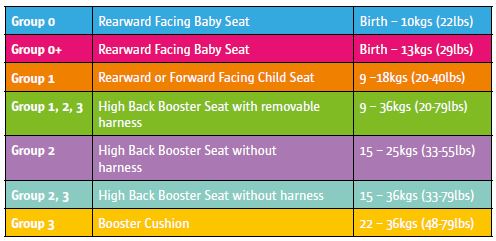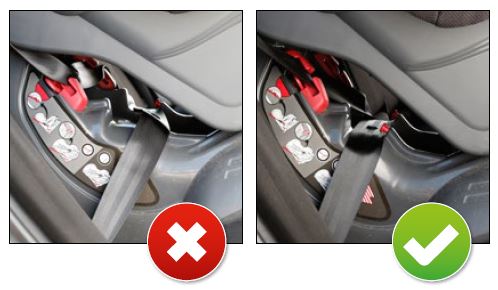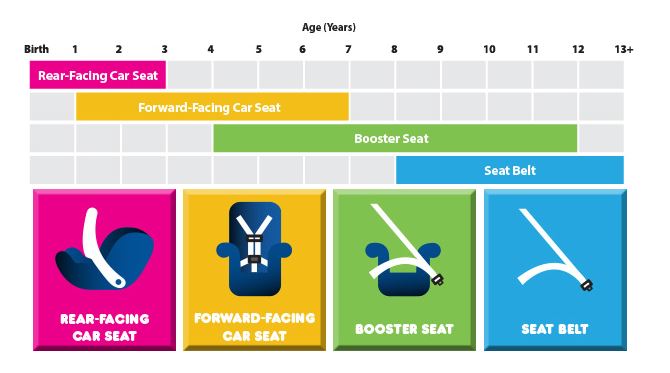Child car seat guide
First time guide to child car seats
A parents number one priority is the safety of their child. With more and more accidents occurring so frequently on the roads it is imperative that parents take all measures to secure this safety. The best way to do this is to ensure you have a properly installed car seat.
The Road Safety Authority’s (RSA) data reveals that an astonishingly high number of children are not restrained or are incorrectly restrained when travelling in a car.
Children are the most at-risk passengers in a vehicle. In the event of an incident, they are the most vulnerable to serious injuries. Between 1996 and 2012, 262 kids lost their lives on Irish roads and nearly a third of them had no seatbelt or child restraint.
The law in Ireland states that any child under 150cm (4ft 11”) or 36kg (5.7 stone) must be fitted with an appropriate child seat. The height and weight of the child are the two most important factors in determining the right choice of car seat. Car seats are necessary for a child up to 3 years of age or below and even after this up to the age of 12 years it is a requirement to use a booster seat up to age 12.
Common mistakes made by car sear users
The points below are not only common mistakes made by parents but are in fact stated under the law.
-
Not having a car seat at all
-
Sitting a child on their lap
-
Placing a rear-facing car seat in the front seat when the airbag is on
-
Taking a child's age as an indicator for which car seat to purchase
-
Any child under the age of 17 is the legal responsibility of the driver
Types of car seats
A correctly fitted child restraint system keeps the child in their seat, preventing them from being thrown around inside or from the vehicle. Furthermore, it also absorbs some of the impact force, this is a very good advantage to have in the event of a crash with the likelihood of your child being injured or killed reduced.
-
rearward-facing baby seat – birth to 10kg (or 13kg for ‘0+’) - Only move your child out of a rearward-facing baby carrier when their head has crowned the top of the seat.
-
rearward or forward-facing child seat – 9-18kg
-
high-backed booster seat without the harness – 15-25kg
-
booster cushion – 22-36kg
A bit more on car seats
-
Infant car seat/Rear-facing car seat - infants should ride in rear-facing seats until the age of two. The rear-faced design gives extra protection to the neck of the child. In the event of a frontal impact, the force of the collision will push the child further into the seat, supporting their head and back. A babies head is a lot heavier in its infant stage and their neck muscles are not sufficiently developed to withstand the force of a crash.
-
Forward-facing car seats - the correct time to use this type of car seat is when the child has reached the correct age and height and has outgrown the previous seat.
-
High back booster seats - the purpose of these seats is that they provide as much possible support to the child's head, neck and spine. It allows them to be raised up to a sufficient amount so the seatbelt is correctly positioned on their body (on the shoulder, not the neck; and on the pelvis, not the stomach). These can sometimes be converted to booster cushions later on.
-
Booster seats - once your child outgrows a forward-facing car seat, it’s time to put him/her in a booster seat until he/she grows old and big enough to be able to use the vehicle’s seat belt safely.

Fitting a car seat
Not only is your choice of car seat paramount but also fitting of the particular seat in your vehicle(s). Once you have chosen the right seat for you and your child you must correctly install the seat.
Always try to choose a retailer to fit the car seat for you. And in turn, they can show you how to install the seat yourself. If you do have to do it yourself then use the points below as a guide.
-
First, you should kneel into the seat exerting your full weight. Then, tighten the seatbelt as much as you can to remove all the slack. This ensures that the seat is fitted as tightly as possible.
-
Hand pressure is not enough when you are securing the child car seat with the seatbelt.
-
To test the seat is fitted correctly - it should sit firmly on the back seat with no forward or sideways movement when tested.
-
Always try to fit the seat in the back of the car, it is safer for the child. If it has to be in the front the airbag must be turned off and roll the seat itself back as far as it can go away from the dashboard.
-
If you take the child seat out of the car, make sure you fit it properly every time you put it back in.
-
Never adjust or modify the seat or seatbelt. A child seat should be suitable for the child and be compatible with the car. Therefore, modifications (changes) to either should not be necessary.
-
The safety belt buckle should not rest on the frame of the child seat causing Buckle Crunch because movement of the car while travelling could cause the buckle to open or on impact, the buckle could be broken causing the child car seat to become loose or detached in the car, giving little or no protection to the child in the seat.
Common fitting errors
-
Safety belt has too much slack in it causing the fitting to be very loose.
-
Safety belt not routed through child seat correctly.
-
Buckle resting against the frame of the child car seat, causing ‘Buckle Crunch’ which may cause the buckle to open.
-
Handle on seat not positioned properly.
-
Child seat is too big or too small for the child.
-
Child seat not compatible with the car.
-
Child seat has exceeded the manufacturer’s recommended guideline for duration of use and is in bad condition.
A checklist to follow when purchasing the correct car seat for you:
Q: Is the car seat suitable for my child?
A: Based on the child's age and weight
Q: Is the car seat suitable for my vehicle?
A: The shape of car seats, the length of seatbelts and the position of seatbelt anchor points are different in different cars. Not all car seats will fit in every car so it's important to check this beforehand.
Q: Does the car seat meet EU standards?
A: EU standard R4403 /04 or i-SIZE (Regulation 129). If so, there should be a yellow or orange sticker with an ‘E’ mark and weight guidelines on the seat.
Q: Are the instructions easy to understand and follow?
A: make sure that there is an easy to follow instruction manual. If you can have the car seat inserted before you purchase it.
Q: Did you take airbags into account?
A: As mentioned previously it is illegal to put a rearward-facing seat in the front seat with an active airbag. Make sure that the seat can be fitted in the back of your vehicle.
Q: Should I buy a second-hand car seat?
A: it is always better to buy a new car seat as you know the standard of compliance, the condition of the seat and you can speak to an expert. Although if you buy second had you must be aware of certain risks associated with them. How old is the seat, is it more than 5 years old, If they've ever been in a crash, are there any parts missing? All things to be considered if you intend to buy secondhand.

Author

Justin Kavanagh
Justin Kavanagh is a recognised leader
in automotive intelligence and vehicle
data supply to the entire motor industry.
He has almost 20 years experience in
building systems from the ground up.
As the Managing Director of Vehicle
Management System, he understands the
need and importance of trustworthy and
reliable vehicle history and advice to
both the trade and the public.
Follow me on LinkedIn
